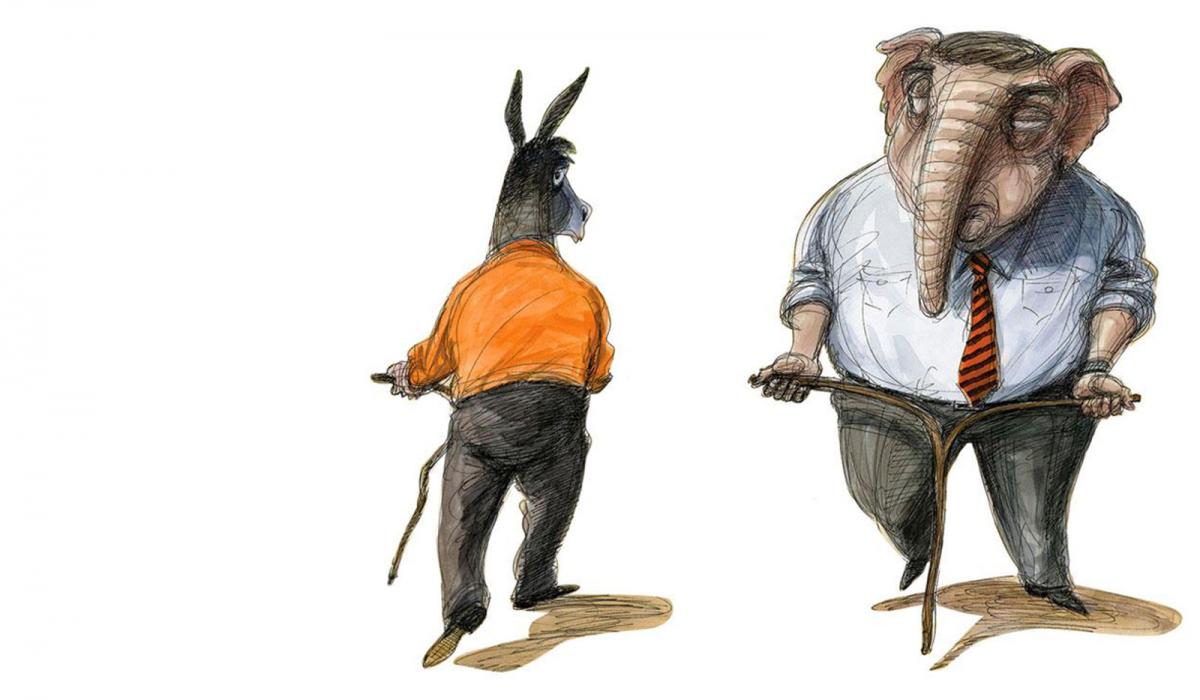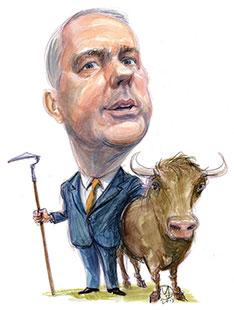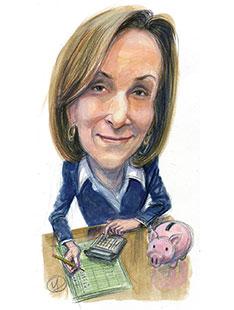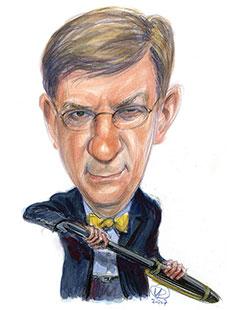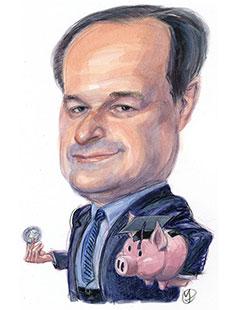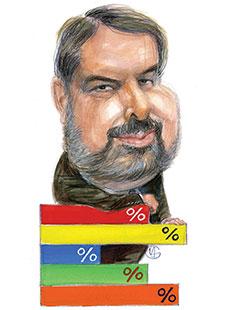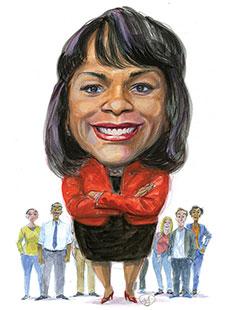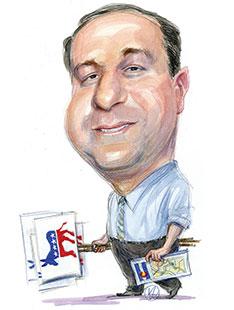Barack Obama left office in January with his reputation burnished but his party decimated. During his eight years in office, the Democrats lost 11 seats in the Senate and 69 in the House, relinquishing control of both chambers. Add to that a loss of 13 governorships and nearly 1,000 state legislative seats around the country — and now, of course, the White House. By those measures, the Democrats are politically weaker than at any time since the Coolidge administration.
Lest the Republican Party get too cocky, though, it woke up the morning after Election Day like someone who had visited a Las Vegas wedding chapel the night before, gotten hitched to a near stranger, and found “Make America Great Again” mysteriously tattooed across their lower back.
What in the name of the Federalist Papers is going on?
Observers from across the ideological spectrum have pronounced this the most chaotic political universe in memory. Deep divisions wrack both parties, Freedom Caucusers and Bernie Sandernistas often as angry at members of their own party as they are at legislators across the aisle. Can the Republicans reconcile deficit discipline and a strategy of economic growth come hell or high water? Will the Democrats ever cross the aisle, or will they stick to a policy that seemed to work well enough for the GOP during the Obama years — a policy of “no”?
In an attempt to make sense of this, over several weeks this winter and spring (before the appointment of Robert Mueller ’66 to oversee the Russia investigation) PAW’s Mark F. Bernstein ’83 asked for the perspectives of more than a dozen alumni and one faculty member from both parties, in and out of government and in and out of Washington. We asked Republicans to talk about the GOP and Democrats to talk about the Democratic Party, and two Washington Post writers who cover politics to chime in as well.
Here’s what they said.
The Republican Party
SETTING THE SCENE:
Juliet Eilperin ’92
Washington Post senior national-affairs correspondent
Although their rolls are somewhat fluid, the House Republican caucus can broadly be divided into three main groups. At the furthest right, you have the Freedom Caucus, which has a few dozen members. They are so safe in their districts that the leadership has very little leverage over them. They can afford to take very conservative positions, even if they are at odds with what the leadership wants, and not face the consequences.
Their polar opposite is the group of moderates known as the Tuesday Group. They are also the smallest wing numerically. These folks used to be more influential within the party, but many of the seats that were once held by moderate Republicans, particularly in the Northeast, are now held by Democrats.
Finally, you have a significant chunk of the Republican conference that is more aligned with Speaker Paul Ryan. They are ideologically conservative, to be sure, but because they also understand the need to produce viable legislation, they are more inclined to make compromises. Even so, while they may be considered pragmatists compared with the Freedom Caucus, their views are still not aligned with Donald Trump’s.
This helps explain why the Republicans, at least in the House, have such difficulty reaching consensus. The only group that is at risk of losing their seats and thus is sensitive to voters is the Tuesday Group. As a result, you don’t see that push toward the center that is historically a part of any legislative compromise. They might be susceptible to pressure if Trump were to campaign against them, but they are not his biggest problem. It’s the much more numerous Freedom Caucus members, who could probably be re-elected even if Donald Trump campaigned against them.
I covered Republicans back in the 1990s and early 2000s when, in many ways, they were at the top of their game. Back when Denny Hastert was speaker and Tom DeLay was majority leader, they had unbelievable discipline and were able to use it to get what they wanted legislatively. I was frankly amazed that the current House leadership couldn’t pass the health-care bill in their first attempt.
Recently I was talking with someone who is in contact with the White House, and this person emphasized that nobody on Trump’s team had ever served in the White House before. That is stunning, and I think you can’t overstate what happens when there is no muscle memory of either forging compromises within one party or working to forge bipartisan compromises with the minority, which is certainly something this majority has shown no interest whatsoever in doing.
Ken Buck ’81
U.S. representative from Colorado
There is a battle for the party going on right now. I believe in a small federal government and in federalism, so I am a more traditional conservative than a lot of Republicans. Many of my colleagues want to be only a little bit better than the Democrats, and that’s the challenge that we have. Are we going to be a conservative party or a Democrat-lite party?This president, to me, is a populist. He has conservative tendencies, but he also has nationalist tendencies. If you look at the people he has surrounded himself with in his Cabinet, they’re certainly conservatives. The same is true of his Supreme Court nominee.
“The Republican Party is much more ideologically diverse than the Democrats. There are economic nationalists. There are Christian conservatives. There is a very strong small-business wing. There are free-market conservatives. And most people in the Republican Party belong to more than one of these wings.”
— Ken Buck ’81
The Republican Party is much more ideologically diverse than the Democrats. There are economic nationalists. There are Christian conservatives. There is a very strong small-business wing. There are free-market conservatives. And most people in the Republican Party belong to more than one of these wings. I represent an agricultural district. The hardest thing to do is to get farmers and ranchers to agree on something, so in that sense I think Republicans are very similar to rural Americans, in that we vote our conscience. We’re not on Team Republican; we’re on Team America. We’re much more willing to go our own way. I think this president, given his background, did a masterful job in winning the nomination against 16 other very qualified candidates. But I think the Republican Party is a very difficult party to build a coalition around.
Nan Hayworth ’81
U.S. representative from New York, 2011–13; ophthalmologist
President Trump ran on the Republican line but did appropriate several significant themes from the Democrats, particularly regarding trade and the way we address entitlements. It was a very different approach from Mitt Romney’s, and it succeeded. All of us as Republicans have to consider how we honor the goals of the party, most importantly fiscal conservatism.If we want to advance fiscally conservative principles, we have to bring people along. People have to understand why it’s important, and I think Donald Trump brings a couple of advantages to doing that. One, he’s not an ideologue. He is a pragmatist. He is a doer. So he will work to get stuff done. Also, he likes to consider himself a success. That is good for all of us, because it means he will stay focused on getting these changes accomplished, but not in an ideological way where we lurch too far in the opposite direction too fast.
“We haven’t had real fiscal conservatism for a long, long time, but it’s only going to happen if folks comprehend the benefits.”
— Nan Hayworth ’81
It is crucial that we engage the public and not just our base. We haven’t had real fiscal conservatism for a long, long time, but it’s only going to happen if folks comprehend the benefits. We have to make that case as Republicans because we face a lot of opposition from the entertainment industry and the media. There is a big megaphone that says if you want to be compassionate, you have to use government mechanisms to administer people’s lives. But you don’t.
James A. Baker ’52
Former U.S. treasury secretary and secretary of state
Every time one party is out of power, that party is seen as extraordinarily impotent. We occupied that position for the last eight years, and now the Democrats have it. And if you look at what’s happening in elections around the country, you would have to conclude that the Republican Party is alive and well. We are winning elections everywhere — and we have been winning over the course of the last several years. It wasn’t all Trump.
We are going to find out if President Trump is truly a conservative, but basically, yes, I think he is. He nominated a conservative justice for the Supreme Court, he is working to cut back on the proliferation of regulations, and he is staffing the government with conservatives.
I suspect that he is going to moderate some of his positions that are not conservative. In fact, he has already begun to do that, for example, on our relations with NATO. When he asked to see me last May [2016], one of the things I suggested was that he take a second look at what he had been saying about NATO and understand that it has, by and large, been an extraordinarily successful security alliance. He should focus his criticism on the fact that our allies are not paying their fair share of the freight. And he has done that.
On trade, I have to tell you that I still worry. I believe in free trade and its benefits. I believe it is important that America remain engaged abroad, because when we’re engaged abroad, we’re a force for good, for peace and stability. I think this administration needs to show that America can lead again. That was one of the biggest deficiencies of the Obama administration. American leadership withered, and we need to get that back. But America can lead without sending in the 101st Airborne. We can lead politically, economically, and diplomatically.
George F. Will *68
Nationally syndicated columnist
We’re going to learn what the country misses when conservatism is missing. Donald Trump said during the campaign that it’s not called the conservative party; it’s called the Republican Party — which was part of his campaign to drain the conservatism from the Republican Party, something he is doing with great speed. He essentially rented the Republican Party.So Mr. Trump is comprehensive in his — I won’t say “rejection” of conservatism, because that would mean that he had thought about it and rejected it — it’s just his indifference to it. He is indifferent to ideas; he is indifferent to the great arguments that have animated American politics.
The defining principle of a republican form of government, said James Madison of the great Class of 1771, is representation, which means the people do not decide issues, they decide who will decide issues. Mr. Trump is having none of that. Trump has a more plebiscitary view of our government. In that sense he is a Jacksonian, claiming an unmediated, almost mystical relationship with The People. Now, The People in this case turns out to be the 46 percent who voted for him and not the 48 percent who voted for his opponent, but ... details.
“There is going to be a banquet on Capitol Hill for four years as Republicans eat the words they have spoken for 40 years.”
— George F. Will *68
Trump’s rise certainly says that the kind of conservative I am — limited government, rule of law, congressional supremacy, a judiciary actively engaged in supervising the excesses of democracy — is a smaller tribe than we thought it was, that a lot of our friends are rhetorical conservatives but operationally something else. They are rhetorical conservatives with a bad case of cognitive dissonance because they don’t want to touch Medicare, Social Security, or the tremendous redistributional activities of the federal government.
Trump presents himself as a nationalist. “Make American Great Again.” It’s America the cowering. Protect us from Mexican products; protect us from all those cheap goods that China keeps sending us because Americans want to buy them. Conservatives who embrace him haven’t faced up to all that protectionism entails. You have embraced the idea that government should pick winners and losers. You are embracing vast executive discretion because Congress, in its slapdash way, has given the president vast discretion to impose tariffs even before he declares a national emergency, which he is also empowered to do. You are saying the government should decide what Americans should consume, in what quantities, and at what prices. Therefore, you are embracing central planning and a whole apparatus of statism, which is why I say that there is going to be a banquet on Capitol Hill for four years as Republicans eat the words they have spoken for 40 years.
Another consequence of Mr. Trump is that liberals are going to become reacquainted with some sensible anxieties. They are going to become acquainted with the perils of an unfettered executive and the virtues of federalism. Well, good, let them discover federalism again! This is going to be a four-year seminar for liberals in the virtues of the Madisonian constitutional architecture.
Ted Cruz ’92
U.S. senator from Texas
We are poised for this to be the most productive Congress in decades. There are four big items on the agenda. Number one is repealing Obamacare. Number two, I think we are likely to see significant regulatory reform. Reducing the regulatory burden on small businesses and job creators can unleash a torrent of economic growth. Number three is tax reform and along with that, I hope, repeal of Dodd-Frank. And number four [was] confirming a strong conservative to replace Justice Scalia on the Supreme Court. If we accomplish all four, 2017 will be a blockbuster year. If we mess them up, 2017 will be a historic missed opportunity.
I think the policies that we have seen from President Trump so far have, by and large, been conservative policies. Much of the media’s attention has focused on a passing statement here or a late-night tweet there. I try not to focus on that noise. It’s easy to be distracted by the circus, and that is one of the media’s favorite games. My focus is on the substance. Look at his Cabinet appointments; this is the most conservative Cabinet we have seen in decades. His early executive actions have also reflected conservative principles, such as green-lighting the Keystone XL pipeline, cutting regulations, freezing civilian hiring, directing the Border Patrol to enforce our laws, and ending taxpayer funding for overseas abortions.
The week after the election, I flew to New York and went to Trump Tower. I spent four and a half hours with the president and vice president and all of his senior team, and the message I conveyed to them was, we have been given an extraordinary opportunity to do a great deal of good. It is rare in the annals of history for Republicans to have control of the White House, of every executive agency, and of both houses of Congress. We shouldn’t waste this historic opportunity.
Robert P. George
McCormick Professor of Jurisprudence and director of the James Madison Program in American Ideals and Institutions
Donald Trump is not a classical conservative. In fact, I can think of no meaningful sense in which he is a conservative at all. There is a question whether the Republican Party will or won’t be Trumpified, but unless President Trump is forced out of office or removed, I think the odds are pretty strong that it will. As for the conservative movement, will they abandon conservatism in favor of Trumpism? That is more of an open question.
Assuming he remains in office, I suspect there will be some conservatives, like [Speaker of the House] Paul Ryan, who will have a transactional relationship with the president, allying on some issues but not others. Some conservatives, like [journalist] Bill Kristol, will continue to have an adversarial relationship with him. Others will just snuggle up to power. They will continue to claim to be conservatives, but they will have abandoned conservative values to Trump in any cases where those values conflict with his, such a free trade, limited government, and some important moral-values issues.
Conservatives never really controlled the Republican Party; they had a transactional relationship with the Republican establishment. So Trump didn’t so much wrest control of the party from the conservatives as from the establishment. He came in and, like Michelangelo perceiving David in the stone, saw something that everybody else had missed, which was the disaffection of working-class Americans in places like Appalachia, where I grew up. These were people who felt betrayed by both parties. For a while they made their way into the Republican Party as Reagan Democrats, but after a few decades they decided that the Republican establishment had abandoned them, too. They never had a strong tie to conservatism. They were union people. Their link to the conservative movement was social issues.
Dan Schwartz ’72
Nevada state treasurer
I am a conservative, but we have a special situation here. Our governor, Brian Sandoval, has sort of divorced himself from the Republican Party, which was squarely for Trump. When I go out and speak to groups I ask, “Who’s a conservative?” And everybody raises their hand. I ask, “Who’s a constitutionalist?” Again, every hand goes up. But we’re here to govern, not to be ideologues. So all of the conservative-versus-liberal talk ... people are more pragmatic. Here in Nevada, we have been promoting education-savings accounts; we have taken action against payday loans. Our brand of conservatism is more focused on results and real problems.I don’t think it really matters if Trump is or isn’t a conservative. I’ve seen no consistency in his positions. He’s not going to build a wall. He’s not going to stop immigration — in Reno, contractors are six months behind on their construction schedules because they can’t find enough workers. But he has put a stop to Elizabeth Warren, Bernie Sanders, and Nancy Pelosi, and that’s the most important thing. You’ve had 20 or 30 years of Washington inserting itself into people’s lives, and it has gummed up the works.
“Here in Nevada, we have been promoting education-savings accounts; we have taken action against payday loans. Our brand of conservatism is more focused on results and real problems.”
— Dan Schwartz ’72
A lot of people without college degrees are politically engaged, and they don’t like what the Democrats have done. Hillary Clinton and Mitt Romney made the same mistake of ignoring the white working class. That’s writing off half the American population — you can’t do that. Trump spoke to them. But this view of The New York Times and The Washington Post that he was backed solely by an army of illiterates is not true. I have been surprised by the number of college-educated professionals who voted for him, too.
The Republican Party does need to become more inclusive. But the counter-argument is that the Democrats can’t just have a give-away economy. That’s not how this country was built.
The Democratic Party
SETTING THE SCENE:
Catherine Rampell ’07
Nationally syndicated columnist for The Washington Post
The Democratic Party is relatively hollowed out. They don’t have a deep bench when it comes to the next presidential election. Beyond that, it’s not clear that they have a strategy for mobilizing newly energized voters. There is a lot of anger at the grassroots level, but it is not clear if the party has figured out how to harness it and promote its own agenda.
Can the Democrats defeat the Trump agenda by just being the Party of No? Well, it seemed to work for Republicans. They ran for six years on repealing Obamacare without developing a viable replacement for it. Maybe Democrats can just try to block everything. Their tools are going to be limited.
People I have spoken to in the state parties did not feel that President Obama worked to connect the national party organization to the state and local parties, who are the ones knocking on doors, organizing, and recruiting candidates for the down-ballot offices. There is also the schism within the Democratic Party itself, between the so-called establishment, who supported Hillary Clinton and free trade or market-based solutions to economic problems, against this rising socialist tide, particularly among younger people, that was very enthusiastic for Bernie Sanders. Who now leads the party when these two major factions do not agree on some very basic issues?
Mark Mellman ’78
President and CEO, The Mellman Group; longtime Democratic pollster
Things are not good for the Democrats, but they’re not as bad as they look. When you have a president in power for eight years who brought a lot of new people into office with him, you’re going to lose some of that over time. But as a practical matter, we don’t control any key institutions, and that’s a problem for a party that wants to govern.There’s a whole set of people the party is not talking to. Hillary Clinton won 19 states; if the Democrats only win Senate seats in states that she won, they’re stuck in the minority. She won 205 congressional districts; if they only win those, they don’t get to a majority. So they have to be able to speak to people who were not spoken to in a persuasive way during the last presidential race.
“Democrats are increasingly concentrated in cities and along the coasts. They have become a party of groups: African Americans, Latinos, Jews, gays.”
— Mark Mellman ’78
There were three aspects to Clinton’s loss that speak to some of the party’s current problems. One is economic. Democrats have some great plans, but people don’t understand their theory of the economy because they haven’t presented one. Republicans do present a clear theory: Cut taxes, get rid of regulations, and business will grow. That may or may not be true — that’s not the point — but it’s understandable.
Second, there is a cultural problem. Democrats are increasingly concentrated in cities and along the coasts. They have become a party of groups: African Americans, Latinos, Jews, gays. That makes it hard to connect with small-town America. Obviously, we have to be true to our values, but we have to do a better job of emphasizing our interest in there being one nation and one people.
Finally, there is an emotional piece. Many of Trump’s less-educated white, working-class voters are people who feel that something has been taken away from them in our changing society. These are people who thought that people like them were economically central, culturally ascendant, and politically potent — and that the gains of other groups, especially racial minorities, have come at their expense. That also is something that Democrats have not spoken to well.
Since the election, people have been expressing their opposition to Trump’s policies in the streets and in town halls, and I think that’s great. But if the Democrats form what some have called a Tea Party of the Left, and go to war against other Democrats, that’s more problematic. If senators such as Heidi Heitkamp in North Dakota [a Mellman client] or Joe Manchin in West Virginia don’t have some freedom to take positions out of the party mainstream, that is going to be bad for the party. If we demand ideological purity on the left, we are not going to have a majority.
Eric Johnson *03
Texas House of Representatives and member of the national Democratic Legislative Campaign Committee
I’m not happy with how the last election turned out, but there is a bigger problem that has not gotten as much attention — and that is the structure of the Democratic Party at the state and local level. Over the last eight years, we have taken it on the chin in state legislatures across the country.
I wouldn’t blame it on Barack Obama directly, but I would say that the national party has not prioritized state candidates and office holders. We have not viewed state legislatures as farm teams for our next crop of congressional or gubernatorial candidates. Republicans have done that very well. On the Democratic side, to be frank, people are obsessed with presidential politics. It’s sexier. But you pay a price for putting so much focus on the highest office in the land to the exclusion of getting folks elected to offices that aren’t as exciting, like state legislatures or even county offices.
Texas is moving toward becoming a purple state. It’s the rate at which it is moving that people disagree on. I think it is overstated how quickly demographics will get us there. There is a theory that as the state becomes more brown, it will become more Democratic. But there is no evidence that Latino voters will be as loyal to the Democratic Party as, say, African American voters have been.
What will turn Texas purple sooner than identity politics is issues. When more people move to Texas, they see how bad Republicans are at actually governing. When you hand them the reins of power, they give you an education system that is ranked in the bottom five, wage stagnation, and low-paying jobs. At some point people will say, can we see what the opposition party looks like, maybe give them a chance?
Terri Sewell ’86
U.S. representative from Alabama
Elections have consequences, so I think our party has taken this defeat seriously. We truly believe that our policies are in the best interests of the country, and we must rededicate ourselves to delivering that message everywhere. We are a big-tent party and always have been.In recent elections, we have seen the rise of the Tea Party, the far right, and now the alt-right. This country still has a problem with race, and I would not be honest if I didn’t say that I thought that had a lot to do with it. Trump’s theme, Make America Great Again, and a lot of his rhetoric have been quite divisive. People want jobs, better opportunities for their children, and affordable health care. They want to be heard and matter. But somewhere along the line, the Rust Belt, the Deep South, and white labor felt neglected, and Trump took advantage of that.
“We have to promote jobs, jobs, jobs ... . There are ways to promote equal opportunities as well as economic opportunities.”
— Terri Sewell ’86
Democrats have to win back our traditional base of workers, because we’re the ones defending collective bargaining and making sure that fair-labor standards are met. We have to promote jobs, jobs, jobs, and there is a way to have jobs, jobs, jobs without discrimination in the workplace. There are ways to promote equal opportunities as well as economic opportunities.
Herman Quirmbach *83
Iowa state senator
At the state level, the critical election was 2010. It was a Republican wave election, which is not unusual when the presidency is controlled by the opposite party, but the Republicans were particularly strategic by taking control in a lot of state legislatures and then using their power to redistrict them in a way that has really tipped the table in their favor. So we need to win some elections.Barack Obama was very popular here in 2008 and 2012, but there is a cyclical tide. Either the people who lost get fired up, or the people who won get disillusioned, or the people in the middle get fed up, so you have this swing back and forth. After two terms of a Democratic president, one would have predicted a Republican win for the presidency. What can Democrats do to get the pendulum swinging the other way? I think it already is. You can see it in the town-hall meetings.
“There is a cyclical tide. Either the people who lost get fired up, or the people who won get disillusioned, or the people in the middle get fed up ... ” — Herman Quirmbach *83
We have a base of enthusiasm to build on. Some of the issues that Republicans have been able to manipulate have died away. Same-sex marriage is now a settled issue, especially among young people. They care about the environment and education. A lot of them, though, are skeptical toward all political parties, the Democrats included. There is a group here called the Ames Progressive Alliance. Some of us in the local Democratic Party would like to bring them into the fold, but there is resistance. They want to keep the focus local and they don’t necessarily want to line up with either party. So we have to build credibility with those folks. We also need some new leadership that encourages people to run for local office. Those offices are not only stepping-stones — it was for me — but they are offices where you can get a whole lot done.
In the short term, we have to focus on the governorships. If we can take enough governorships in 2018, we will have a voice in the reapportionment process after the 2020 census. If we don’t make substantial progress, Republicans will gerrymander the districts again and Democrats will be stuck for another decade.
Josh Marshall ’91
Editor and publisher of the website Talking Points Memo
It’s somewhat overstated how bad a position the Democrats are in. On the one hand, they have been devastated at the state level. Having said that, in the last three presidencies, the “in” party — the presidential party — has been devastated at the congressional and local level. It happened with Clinton, it happened with George W. Bush, and it happened with Obama. Over the last 20 years, we have had big wave elections, in both directions. Democrats are in a deep hole, but this is an era when holes get filled quickly.
Still, during the Clinton and Bush eras, there was a kind of centrist Democrat that just doesn’t exist anymore. This race for chair of the Democratic National Committee was a good illustration of this. Tom Perez and Keith Ellison are both pretty progressive, though the contest was portrayed as a stark battle between the Hillary and Bernie wings of the party. To a certain extent it was, but their differences are nothing like the policy differences among Democrats in the ’90s.
One of the critiques that came out of the 2016 election was that Democrats had nothing to say to declining industrial towns in the Midwest. I think that is greatly overstated. They had a lot of things to say, and most of the things in Trump’s platform were things that Democrats can’t and won’t say: that immigrants have taken your jobs or that we should be kicking ass around the world because people have hurt us. But there were a lot of voters who voted for Obama in 2012 and voted for Trump four years later. You can motivate people to vote by more inclusive politics or by xenophobia. Obama did one, Trump did the other.
For the midterms, I think the Democrats need to paint a big picture of how society ought to be run and identify three or four big things they would do if they were in power. They need to articulate a policy agenda that gets people to consistently vote year after year because they believe it will improve their lives. That’s complicated. One of the problems for the Democrats is that policy doesn’t matter that much unless it is built into a politics. Democrats often fool themselves that they have the issue agenda covered because they have the policies. But if it’s not woven together into a politics, it doesn’t matter.
Jeff Merkley *82
U.S. senator from Oregon
Over the last four decades, virtually all the new income in America has gone to the top 10 percent. I grew up in a blue-collar community, and I saw the great economic leap forward in my parents’ generation. People anticipated that it would continue, but something went terribly wrong in the mid-’70s, and part of it is that we created a tilted playing field for American manufacturing. We gave enormous advantages to our competitors. We have to address that, and take into account that automation is another emerging threat to middle-class jobs.
Democrats have to do a much better job connecting with rural America. I come from rural America; I have seen the impact on small towns of the changing economy. But rural America has benefited enormously from the Affordable Care Act. Nearly one out of three rural Oregonians is on the Oregon health plan, so eliminating the expansion of Medicaid is going to have a profound impact on their health care and peace of mind. Democrats have been standing up for rural America, but we need to strengthen that connection.
Jared Polis ’96
U.S. representative from Colorado
We’re at a record-low number of governors and state legislative bodies. We still got 3 million more votes for president, but in many ways that was due to the weakness of the Republican candidate. We are competitive in the House, other than the fact that the districts favor the Republicans. So the nation is divided now. Neither party is very popular.I think that one of the ways Donald Trump was able to win was to distance himself from the traditional Republican brand. Now, of course, the Democrats are uniformly in opposition, which certainly makes it easier from an intellectual perspective and a marketing perspective to pick and choose the least popular policies that Trump pursues and market ourselves as the alternative.
“We need to run candidates with a compelling local story who can compete in every state. There’s a different coalition to be built in every district.”
— Jared Polis ’96
Barack Obama’s personal charisma and integrity didn’t transfer to other office-seekers. You can’t rely on one person to move a party forward. We always want to build our county and state parties. There are a lot of new, enthusiastic people who have joined the party. Transforming their excitement is going to be a big part of the challenge for all party leaders at all levels.
When I entered Congress, we had Democratic representatives from North Dakota, South Dakota, even Idaho. We need to run candidates with a compelling local story who can compete in every state. There’s a different coalition to be built in every district, though.
Republicans are more comfortable being out of power. They like to attack and complain. That’s what the Freedom Caucus does, and they’re very good at it. Democrats actually like to be governing.
Mark F. Bernstein ’83 is PAW’s senior writer.

